-
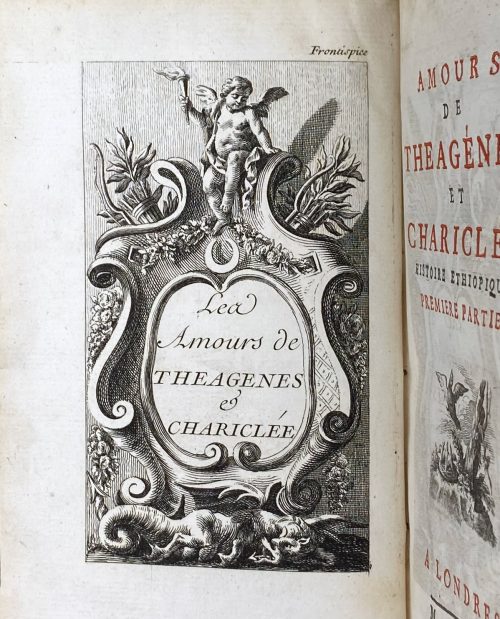 Two volumes in-16o, 16.3 x 10.3 cm, uniformly bound in marbled calf with gilt triple-fillet border, flat spine with gilt lozenges in compartments, two crimson labels with gilt lettering, marbled endpapers, all edges gilt, with engraved title, 2 title vignettes, 11 copper plate engravings, incl. title/frontispiece in vol. 1, and 10 headpieces (two of them similar), printed on laid paper. Vol. 1: Livres 1 – 5. Engraved title-page: Cartouche with the title "Les | Amours de | THEAGENES | & | CHARICLÉE", with a Cupid holding a torch on top and a defeated winged dragon at the bottom; Cupid's quivers with bows and arrows beside. Collation: 8vo; a5 (t.p., preface), A-N8 O4 (O4 blank), total 113 leaves plus 6 unsigned engraved plates, incl. engraved title as frontispiece, unsigned; 5 different headpieces, unsigned. Pagination: [i, ii] iii-x, [1] 2-213 [3] (blank), total 226 pages, ils. Vol. 2: Livres 6 – 10. Collation: 8vo; π1 (t.p.), A-M8, total 97 leaves plus 6 unsigned plates, incl. the Conclusion, no frontispiece; 5 headpieces, the headpiece for Livre 7 similar to Livre 4. Pagination: [2] [1] 2-190 [2] (blank), total 194 pages, ils. Letterpress title-page (red and black) in each volume: AMOURS | DE | THEAGÉNES | ET | CHARICLÉE• | HISTOIRE ETHIOPIQUE. | PREMIERE (SECONDE) PARTIE. | {vignette} | A LONDRES, | — | M. DCC. XLIII. || According to Cohen-DeRicci, this is the first anonymous edition with 9 different headpieces; the second edition in the same 1743 was published by Antoine Urban Coustelier (French, 1714 – 1763) in Paris with less provocative headpiece vignettes. The original text belongs to Héliodore d'Emèse, i.e. Heliodorus [Ἡλιόδωρος] (Greek, 3rd – 4th century AD). The earliest translation into French was performed by Jacques Amyot (French, 1513 – 1593) and published by J. Longis in Paris in 1547. The new translation is credited by Lewine to Jean de Montlyard (French/Swiss, 17th century), first published in Paris in 1620. However, most scholars attribute it to Louis François de Fontenu (French, 1667 – 1759), Bernard Le Bovier de Fontenelle (French, 1657 – 1757) or Germain François Poullain de Saint-Foix (French, 1698 – 1776), first published in 1727 by Herman Uytwerf (Dutch, 1698 – 1754) in Amsterdam. Catalogue raisonné : J. Lewine, 236; Cohen-DeRicci, 478. Information about the story can be found here: Aethiopica.
Two volumes in-16o, 16.3 x 10.3 cm, uniformly bound in marbled calf with gilt triple-fillet border, flat spine with gilt lozenges in compartments, two crimson labels with gilt lettering, marbled endpapers, all edges gilt, with engraved title, 2 title vignettes, 11 copper plate engravings, incl. title/frontispiece in vol. 1, and 10 headpieces (two of them similar), printed on laid paper. Vol. 1: Livres 1 – 5. Engraved title-page: Cartouche with the title "Les | Amours de | THEAGENES | & | CHARICLÉE", with a Cupid holding a torch on top and a defeated winged dragon at the bottom; Cupid's quivers with bows and arrows beside. Collation: 8vo; a5 (t.p., preface), A-N8 O4 (O4 blank), total 113 leaves plus 6 unsigned engraved plates, incl. engraved title as frontispiece, unsigned; 5 different headpieces, unsigned. Pagination: [i, ii] iii-x, [1] 2-213 [3] (blank), total 226 pages, ils. Vol. 2: Livres 6 – 10. Collation: 8vo; π1 (t.p.), A-M8, total 97 leaves plus 6 unsigned plates, incl. the Conclusion, no frontispiece; 5 headpieces, the headpiece for Livre 7 similar to Livre 4. Pagination: [2] [1] 2-190 [2] (blank), total 194 pages, ils. Letterpress title-page (red and black) in each volume: AMOURS | DE | THEAGÉNES | ET | CHARICLÉE• | HISTOIRE ETHIOPIQUE. | PREMIERE (SECONDE) PARTIE. | {vignette} | A LONDRES, | — | M. DCC. XLIII. || According to Cohen-DeRicci, this is the first anonymous edition with 9 different headpieces; the second edition in the same 1743 was published by Antoine Urban Coustelier (French, 1714 – 1763) in Paris with less provocative headpiece vignettes. The original text belongs to Héliodore d'Emèse, i.e. Heliodorus [Ἡλιόδωρος] (Greek, 3rd – 4th century AD). The earliest translation into French was performed by Jacques Amyot (French, 1513 – 1593) and published by J. Longis in Paris in 1547. The new translation is credited by Lewine to Jean de Montlyard (French/Swiss, 17th century), first published in Paris in 1620. However, most scholars attribute it to Louis François de Fontenu (French, 1667 – 1759), Bernard Le Bovier de Fontenelle (French, 1657 – 1757) or Germain François Poullain de Saint-Foix (French, 1698 – 1776), first published in 1727 by Herman Uytwerf (Dutch, 1698 – 1754) in Amsterdam. Catalogue raisonné : J. Lewine, 236; Cohen-DeRicci, 478. Information about the story can be found here: Aethiopica. -
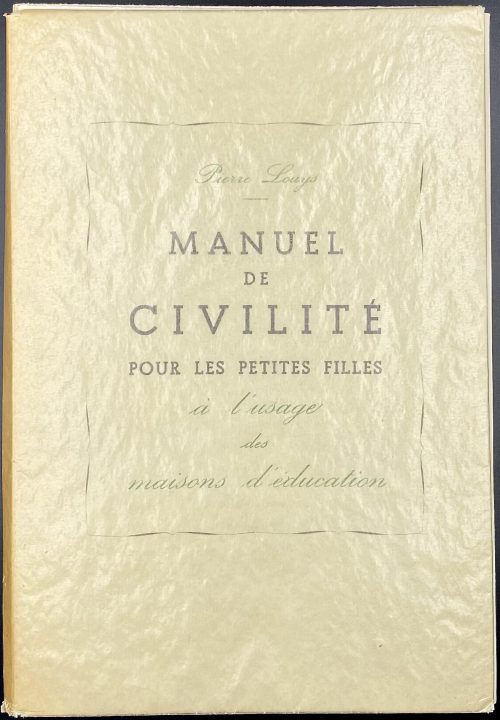 Description: Softcover 25 x 17 cm in the publisher’s French flapped wrappers lettered to front in black and green « Pierre Louys | MANUEL | DE | CIVILITÉ | POUR LES PETITES FILLES | à l'usage | des | maisons d'éducation » in a frame; unbound, 14 loose bifold wove paper (BFK Rives) sheets collated 4to, in glassine dust jacket, in slipcase; pp.: [1-10] 11-104 [8], total 56 leaves plus 12 laid-in plates after an anonymous artist’s watercolours and drawings reproduced by photogravure and stencil-coloured (au pochoir). Title-page: MANUEL | DE | CIVILITÉ | POUR LES PETITES FILLES | à l'usage | des | maisons d'éducation | ~ | LONDERS | MCMXLVIII || Limitation: 299 copies of which 1 copy (№ UN) on Vieux Japon enriched with the original watercolours and drawings and a b/w suite; 6 copies on Auvergne, each with one original watercolour and a b/w suite (№ I-VI); 6 copies on Auvergne each with one original drawing and a b/w suite (№ VII-XII); 15 copies on Auvergne enriched with a b/w suite (№ XVIII-XXVIII); 271 copies on Vélin de Rives (№ 1-271). This is copy № 91. Publisher, printer, artists – anonymous and unknown. Clandestine edition, marked "London", i.e. Nice, France. Catalogue raisonné: Dutel (1920-1970) № 1920, p. 251. For the original edition, see: LIB-3116.2022.
Description: Softcover 25 x 17 cm in the publisher’s French flapped wrappers lettered to front in black and green « Pierre Louys | MANUEL | DE | CIVILITÉ | POUR LES PETITES FILLES | à l'usage | des | maisons d'éducation » in a frame; unbound, 14 loose bifold wove paper (BFK Rives) sheets collated 4to, in glassine dust jacket, in slipcase; pp.: [1-10] 11-104 [8], total 56 leaves plus 12 laid-in plates after an anonymous artist’s watercolours and drawings reproduced by photogravure and stencil-coloured (au pochoir). Title-page: MANUEL | DE | CIVILITÉ | POUR LES PETITES FILLES | à l'usage | des | maisons d'éducation | ~ | LONDERS | MCMXLVIII || Limitation: 299 copies of which 1 copy (№ UN) on Vieux Japon enriched with the original watercolours and drawings and a b/w suite; 6 copies on Auvergne, each with one original watercolour and a b/w suite (№ I-VI); 6 copies on Auvergne each with one original drawing and a b/w suite (№ VII-XII); 15 copies on Auvergne enriched with a b/w suite (№ XVIII-XXVIII); 271 copies on Vélin de Rives (№ 1-271). This is copy № 91. Publisher, printer, artists – anonymous and unknown. Clandestine edition, marked "London", i.e. Nice, France. Catalogue raisonné: Dutel (1920-1970) № 1920, p. 251. For the original edition, see: LIB-3116.2022. -
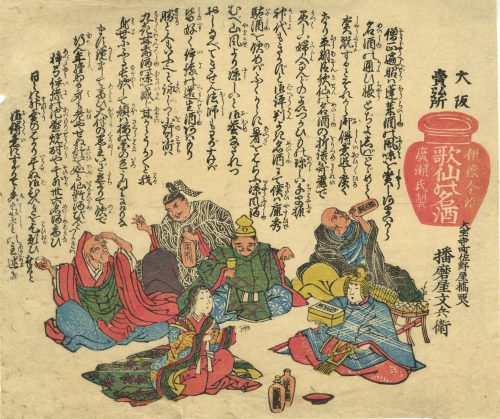 An uncut fan print uchiwa-e, size 22.7 x 28.7cm, by an unknown artist.
An uncut fan print uchiwa-e, size 22.7 x 28.7cm, by an unknown artist. -
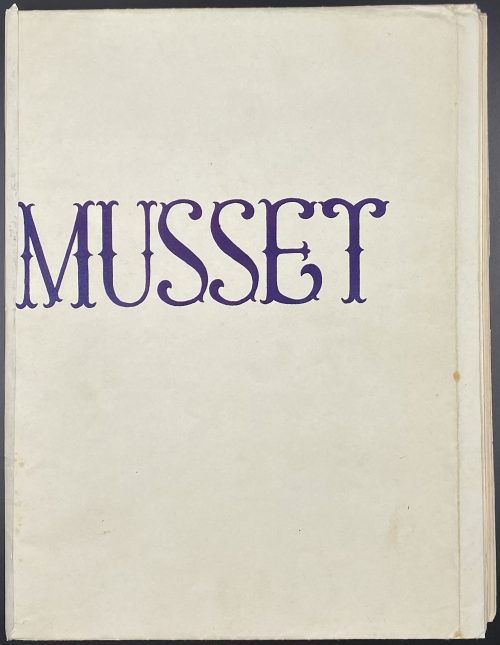 Description: one volume in French flapped wrappers 25.3 x 19 cm, lettered “MUSSET” to front, 5 gatherings of 4 and one of 6 leaves, 26 leaves total, pp.: [4] [2] 3-43 [44] [4], total 52 pages, incl. those in wrappers, unbound; plus coloured and uncoloured suites of 12 lithographs, in a paper folder; in a cardboard tan slipcase 2.8 x 19.3 cm. Artist unknown, publisher unknown, published at the end of 1940s (per J.-P. Dutel). Illustrations are a loose interpretation of original lithographs by Devéria and Henri Grévedon or Octave Tassaert for the 1833 edition ((1926 re-print LIB-3135.2023). Limitation: Edition limited to 250 copies printed on Vélin Chiffon numbered 1 -250 and 24 copies marked by letters A to Z. This is copy № 246, with two suites of plates, one coloured and one b/w. Catalogue raisonné: Dutel (1920-1970) № 1657, p. 189. Alfred de Musset (French, 1810 – 1857) – author.
Description: one volume in French flapped wrappers 25.3 x 19 cm, lettered “MUSSET” to front, 5 gatherings of 4 and one of 6 leaves, 26 leaves total, pp.: [4] [2] 3-43 [44] [4], total 52 pages, incl. those in wrappers, unbound; plus coloured and uncoloured suites of 12 lithographs, in a paper folder; in a cardboard tan slipcase 2.8 x 19.3 cm. Artist unknown, publisher unknown, published at the end of 1940s (per J.-P. Dutel). Illustrations are a loose interpretation of original lithographs by Devéria and Henri Grévedon or Octave Tassaert for the 1833 edition ((1926 re-print LIB-3135.2023). Limitation: Edition limited to 250 copies printed on Vélin Chiffon numbered 1 -250 and 24 copies marked by letters A to Z. This is copy № 246, with two suites of plates, one coloured and one b/w. Catalogue raisonné: Dutel (1920-1970) № 1657, p. 189. Alfred de Musset (French, 1810 – 1857) – author. -
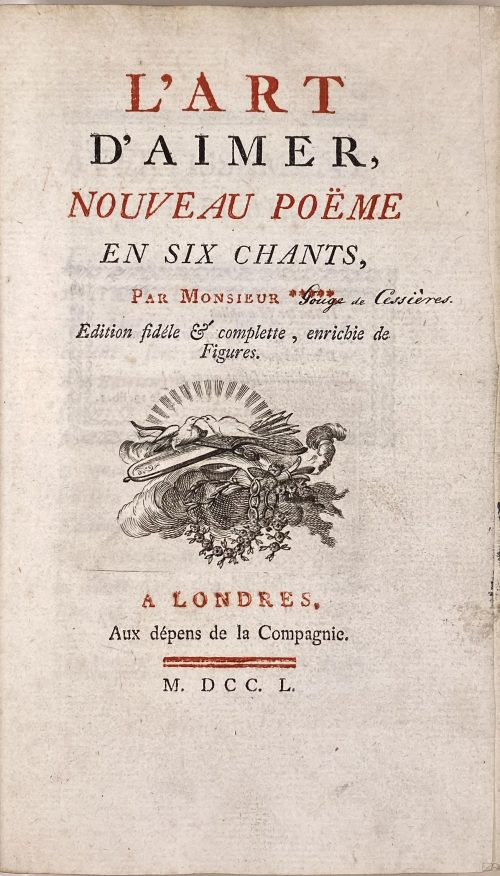 Description: 19th-century binding, 8vo,18.9 x 11.7 cm, in patterned quarter green shagreen over marbled boards, gilt elements and lettering to spine (reliure romantique), printed on laid paper, with tall "s", margins sprinkled blue. Title-page (red and black): L'ART | D'AIMER, | NOUVEAU POËME | EN SIX CHANTS, | Par Monsieur ***** Gouge de Cessières. | Edition fidéle & complette, enrichie de | Figures. | {vignette} | A LONDRES. | Aux dépens de la Compagnie. | = | M. DCC. L. || Includes: La Mort de Zulnï (pp. 175-190 ), Idée de l'Art d'aimer d'Ovide (pp. 191-244), and Lettre écrite à Monsieur *** de ******de l'Académie... (pp. 245-261). Collation: 8vo; a-b8, A-Q8 R3, lacking K2 (pp. 147/8); total 146 leaves (of 147) plus 8 engraved plates, unsigned, incl. frontispiece. Pagination: [i, ii] iii-xxxii, [1, 2] 3-261 [262 blank], lacking pp. 147/8 (K2), possibly containing Argument du chant VI; total 292 pages (of 294), ils. Catalogue raisonné: Cohen-DeRicci (under Ovid) 775, Lewine (under Ovid) 398. The artist and engravers of this edition are unknown. "Another edition, Londres (Paris), 1760, with frontispiece after Eisen by Martinet, and 6 plates after Martinet". Contributors: François-Étienne Gouge de Cessières (French, 1724 – 1782) – author. Ovid [Publius Ovidius Naso] (Roman, 43 B.C. – A.D. 17) – author. Aux dépens de la Compagnie (1685 – 1780) (Amsterdam) – publisher.
Description: 19th-century binding, 8vo,18.9 x 11.7 cm, in patterned quarter green shagreen over marbled boards, gilt elements and lettering to spine (reliure romantique), printed on laid paper, with tall "s", margins sprinkled blue. Title-page (red and black): L'ART | D'AIMER, | NOUVEAU POËME | EN SIX CHANTS, | Par Monsieur ***** Gouge de Cessières. | Edition fidéle & complette, enrichie de | Figures. | {vignette} | A LONDRES. | Aux dépens de la Compagnie. | = | M. DCC. L. || Includes: La Mort de Zulnï (pp. 175-190 ), Idée de l'Art d'aimer d'Ovide (pp. 191-244), and Lettre écrite à Monsieur *** de ******de l'Académie... (pp. 245-261). Collation: 8vo; a-b8, A-Q8 R3, lacking K2 (pp. 147/8); total 146 leaves (of 147) plus 8 engraved plates, unsigned, incl. frontispiece. Pagination: [i, ii] iii-xxxii, [1, 2] 3-261 [262 blank], lacking pp. 147/8 (K2), possibly containing Argument du chant VI; total 292 pages (of 294), ils. Catalogue raisonné: Cohen-DeRicci (under Ovid) 775, Lewine (under Ovid) 398. The artist and engravers of this edition are unknown. "Another edition, Londres (Paris), 1760, with frontispiece after Eisen by Martinet, and 6 plates after Martinet". Contributors: François-Étienne Gouge de Cessières (French, 1724 – 1782) – author. Ovid [Publius Ovidius Naso] (Roman, 43 B.C. – A.D. 17) – author. Aux dépens de la Compagnie (1685 – 1780) (Amsterdam) – publisher. -
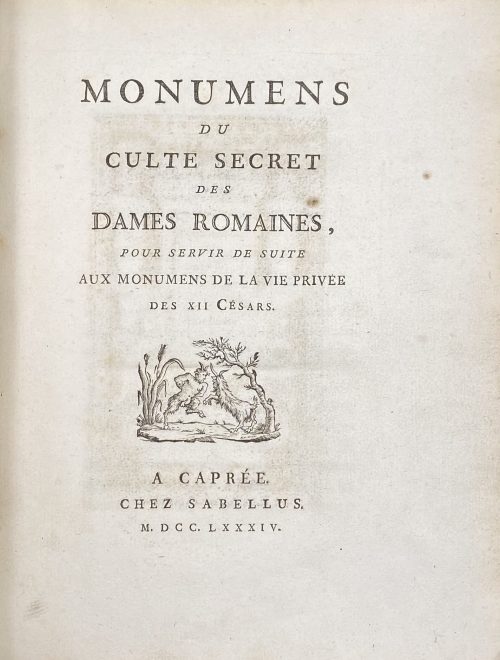 One volume, 25.8 x 20.7 cm, laid paper 25.2 x 19.5 cm, platemark 13.3 x 7.7 cm, wide margins; bound in calf, ruled in gilt, rebacked, raised bands, blind-stamped flower lozenges in compartments, crimson label with gilt lettering, marbled endpapers, all edges gilt, gilt dentelle inside, engraved bookplate to front pastedown: lettered ribbon: “VINCTUS NON VICTUS”, chained Lion Passant in a collar, below “Maurice B. Worms”. Title-page: MONUMENS | DU | CULTE SECRET | DES | DAMES ROMAINES , | POUR SERVIR DE SUITE | AUX MONUMENS DE LA VIE PRIVÉE | DES XII CÉSARS. | {VIGNETTE} | A CAPRÉE. | CHEZ SABELLUS. | M. DCC. LXXXIV. || Collation: [A]2 B-G2 2A-Z2 Aa2 Bb1, total 63 leaves, plus engraved title/frontispiece and 50 plates, all unsigned, first and last blanks. Pagination: [i-ii] iii-xxvii [xxviii] 1-98, ils., total 126 pages. Catalogue raisonné: Cohen-De Ricci: 475; Lewine: 233; Dutel (1650-1880) № A-729, p. 223; Pia (1978): col. 884-5, pp. 467-8. Author: Pierre-François Hugues d'Hancarville (French, 1719-1805) – author. Provenance: Maurice Benedict Worms (Austrian, 1805 – 1867), son of Benedikt Moses Worms (1769 – 1824) and Schönche Jeannette Rothschild (1771 – 1859), maternal grandson of Mayer Amschel Rothschild (1744 – 1812), the founder of the House of Rothschild.
One volume, 25.8 x 20.7 cm, laid paper 25.2 x 19.5 cm, platemark 13.3 x 7.7 cm, wide margins; bound in calf, ruled in gilt, rebacked, raised bands, blind-stamped flower lozenges in compartments, crimson label with gilt lettering, marbled endpapers, all edges gilt, gilt dentelle inside, engraved bookplate to front pastedown: lettered ribbon: “VINCTUS NON VICTUS”, chained Lion Passant in a collar, below “Maurice B. Worms”. Title-page: MONUMENS | DU | CULTE SECRET | DES | DAMES ROMAINES , | POUR SERVIR DE SUITE | AUX MONUMENS DE LA VIE PRIVÉE | DES XII CÉSARS. | {VIGNETTE} | A CAPRÉE. | CHEZ SABELLUS. | M. DCC. LXXXIV. || Collation: [A]2 B-G2 2A-Z2 Aa2 Bb1, total 63 leaves, plus engraved title/frontispiece and 50 plates, all unsigned, first and last blanks. Pagination: [i-ii] iii-xxvii [xxviii] 1-98, ils., total 126 pages. Catalogue raisonné: Cohen-De Ricci: 475; Lewine: 233; Dutel (1650-1880) № A-729, p. 223; Pia (1978): col. 884-5, pp. 467-8. Author: Pierre-François Hugues d'Hancarville (French, 1719-1805) – author. Provenance: Maurice Benedict Worms (Austrian, 1805 – 1867), son of Benedikt Moses Worms (1769 – 1824) and Schönche Jeannette Rothschild (1771 – 1859), maternal grandson of Mayer Amschel Rothschild (1744 – 1812), the founder of the House of Rothschild. -
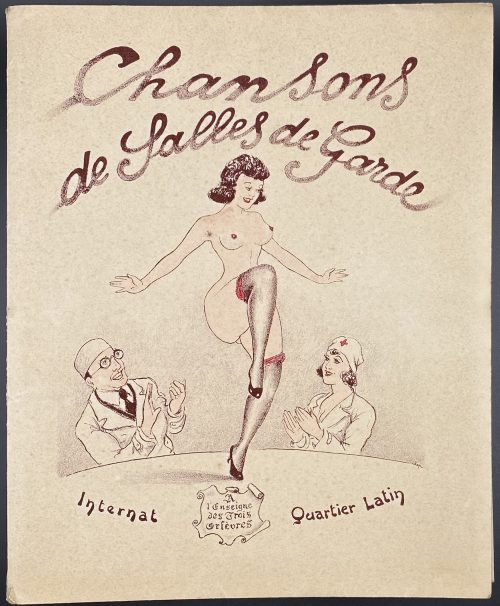 Title: Chansons | de Salles de Garde | {vignette} | Internat { À l’Enseigne des Trois Orfèvres } Quartier Latin || Collation: 21 leaves folded in half (84 pages), unpaginated, unbound, plus 40 plates (two-tone lithography) for 40 songs, in a flapped paper folder, in a green cardstock folder (slipcase without top and bottom?) with gilt diaper ornament. Text, music score, and drawings printed in brick red. Size: 28 x 22.5 cm. Edition: limited to 700 copies of which 100 (№ 1-100) on Vélin Arches, 650 (№ 101-650) on Vélin Spécial, and 50 without numbering marked “Exemplaire d’interne” on Vélin Supérieur. This copy is № 27. Catalogue raisonné: Dutel 1920 – 1970: 1192.
Title: Chansons | de Salles de Garde | {vignette} | Internat { À l’Enseigne des Trois Orfèvres } Quartier Latin || Collation: 21 leaves folded in half (84 pages), unpaginated, unbound, plus 40 plates (two-tone lithography) for 40 songs, in a flapped paper folder, in a green cardstock folder (slipcase without top and bottom?) with gilt diaper ornament. Text, music score, and drawings printed in brick red. Size: 28 x 22.5 cm. Edition: limited to 700 copies of which 100 (№ 1-100) on Vélin Arches, 650 (№ 101-650) on Vélin Spécial, and 50 without numbering marked “Exemplaire d’interne” on Vélin Supérieur. This copy is № 27. Catalogue raisonné: Dutel 1920 – 1970: 1192. -
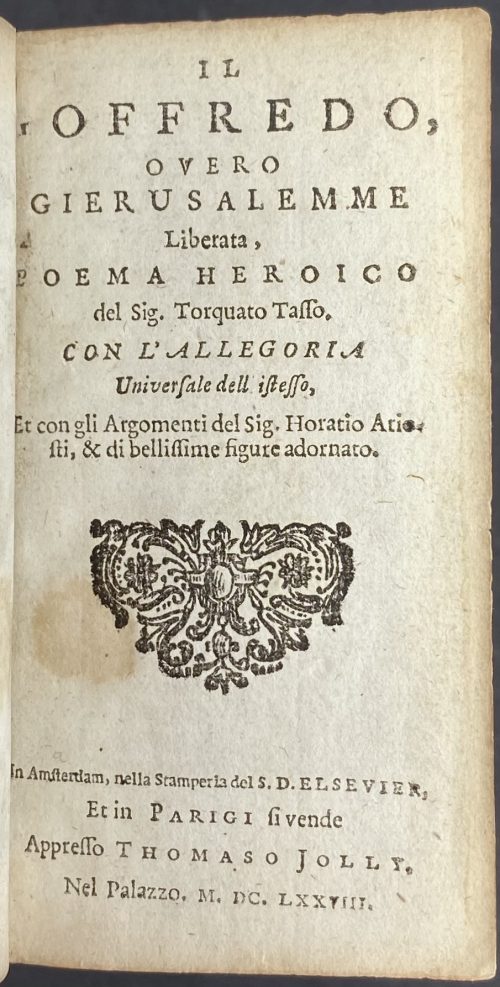 Vol. 1: Engraved t.p.: An architectural setting with flags and arms, and sitting male and female figures in armour, perhaps representing Tancredi and Clorinda, with lettering above their heads: “GIERVSA– | LEMME | LIBERATA”. Title-page: IL | GOFFREDO, | OVERO | GIERUSALEMME | Liberata , | POEMA HEROICO | del Sig. Torquato Tasso. | CON L’ ALLEGORIA | Universale dell istesso, | Et con gli Argomenti del Sig. Horatio Ario- | sti, & di belissime figure adornato. | {woodcut element} | In Amsterdam, nella Stamperia del S.D. ELZEVIER, | Et in Parigi, si vende | Appresso Thomaso Jolly. | Nel Palazzo, M. DC. LXXVIII. || Collation: 8vo; [A1] 1st blank, engraved t.p., [A2] letterpress t.p., pp. [1-4]; signatures start at A3, pagination starts at p. 37; Allegoria: A3-B1, pp. [5-18], Tavola: B2-C2, pp. [19-36]; Il Goffredo: C3-R8, pp. 37-271 [272]. Total A-R8: 136 leaves (272 pages), plus 11 plates, incl. engraved t.p., and frontispiece (sculptural bust portrait of Torquato Tasso in a laurel wreath, with a lettered plate below “TORQVATO | TASSO”). Vol. 1: Title-page: Similar but “TOMO II.” after “sti, & di belissime figure adornato.” and before the woodcut element. Collation: 8vo; 1st blank, letterpress t.p., signatures start at A3, p. 5; A-S8, pp. [4] 5-285 [3]. Total A-S8: 144 leaves (288 pages) plus 10 engraved plates. Binding: Two volumes 15 x 6 cm, uniformly bound in 19th-century green morocco, gilt triple-fillet border, bull heads at corners, spine with raised bands, gilt in compartments, two gilt-lettered crimson labels, blue endpapers, 2 blank laid paper leaves in the front, AEG. Contributors: Torquato Tasso (Italian, 1544 –1595) – author. Daniel Elzevir (Dutch, 1626-1680) – publisher. Thomas Jolly (French, fl. 1648 – 1694) – publisher.
Vol. 1: Engraved t.p.: An architectural setting with flags and arms, and sitting male and female figures in armour, perhaps representing Tancredi and Clorinda, with lettering above their heads: “GIERVSA– | LEMME | LIBERATA”. Title-page: IL | GOFFREDO, | OVERO | GIERUSALEMME | Liberata , | POEMA HEROICO | del Sig. Torquato Tasso. | CON L’ ALLEGORIA | Universale dell istesso, | Et con gli Argomenti del Sig. Horatio Ario- | sti, & di belissime figure adornato. | {woodcut element} | In Amsterdam, nella Stamperia del S.D. ELZEVIER, | Et in Parigi, si vende | Appresso Thomaso Jolly. | Nel Palazzo, M. DC. LXXVIII. || Collation: 8vo; [A1] 1st blank, engraved t.p., [A2] letterpress t.p., pp. [1-4]; signatures start at A3, pagination starts at p. 37; Allegoria: A3-B1, pp. [5-18], Tavola: B2-C2, pp. [19-36]; Il Goffredo: C3-R8, pp. 37-271 [272]. Total A-R8: 136 leaves (272 pages), plus 11 plates, incl. engraved t.p., and frontispiece (sculptural bust portrait of Torquato Tasso in a laurel wreath, with a lettered plate below “TORQVATO | TASSO”). Vol. 1: Title-page: Similar but “TOMO II.” after “sti, & di belissime figure adornato.” and before the woodcut element. Collation: 8vo; 1st blank, letterpress t.p., signatures start at A3, p. 5; A-S8, pp. [4] 5-285 [3]. Total A-S8: 144 leaves (288 pages) plus 10 engraved plates. Binding: Two volumes 15 x 6 cm, uniformly bound in 19th-century green morocco, gilt triple-fillet border, bull heads at corners, spine with raised bands, gilt in compartments, two gilt-lettered crimson labels, blue endpapers, 2 blank laid paper leaves in the front, AEG. Contributors: Torquato Tasso (Italian, 1544 –1595) – author. Daniel Elzevir (Dutch, 1626-1680) – publisher. Thomas Jolly (French, fl. 1648 – 1694) – publisher. -
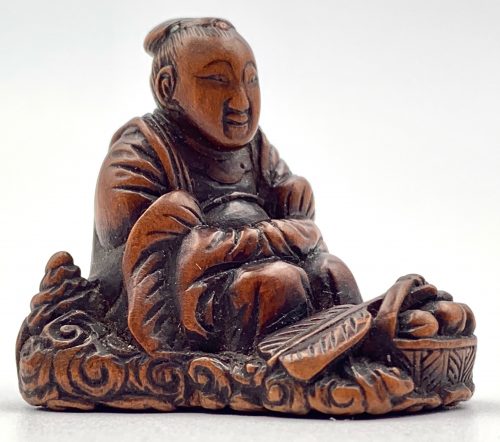 Wood netsuke of Seiōbo with a basket of immortal peaches, seated on a bed of clouds. Carver's signature tablet lost. Circa 1850. Dimensions: 32.6 x 28.1 x 20.1 mm.
Wood netsuke of Seiōbo with a basket of immortal peaches, seated on a bed of clouds. Carver's signature tablet lost. Circa 1850. Dimensions: 32.6 x 28.1 x 20.1 mm.Queen Mother of the West is a calque of Xiwangmu in Chinese sources, Seiōbo in Japan. Peaches of Immortality (Chinese: 仙桃) are consumed by the immortals due to their mystic virtue of conferring longevity on all who eat them.
Provenance: Charles Ephrussi (1849-1905) acquired in the 1870s; a wedding gift in 1898 to his cousin Ritter Viktor von Ephrussi (1860-1945) and Baroness Emilie (Emmy) Schey von Koromla (1879-1938); retrieved post-war by their daughter Elizabeth de Waal (1899-1991); given by her to her brother Ignaz (Iggie) Ephrussi (1906-1994), Tokyo; bequeathed by him to his great-nephew Edmund de Waal (born 1964), London, author of “The Hare with Amber Eyes: a hidden inheritance”. London / New York: Chatto & Windus / Farrar, Straus & Giroux. ISBN 978-0099539551. https://en.wikipedia.org/wiki/Charles_Ephrussi. https://en.wikipedia.org/wiki/Ephrussi_family. https://en.wikipedia.org/wiki/Edmund_de_Waal. -

Iron tsuba pierced and carved (marubori-sukashi) with the 'horse in the round' design. Possibly, Bushū-Ito school, 19th century (ca. 1800). Kogai-hitsu-ana plugged with shakudō.
Size: 67.6 x 66.8 x 5.1 mm
Unsigned.
See:
-
- Robert E. Haynes. Study Collection of Japanese Sword Fittings. Nihon Art Publishers, 2010, p. 120: Iron plate carved and formed in the round as a tethered bull...Signed: Bushū jū Sadayasu saku.
- Robert E. Haynes. Masterpiece and highly important tsuba, etc... San Francisco, 1984 // Catalog #9.: Signed: Bushū jū Yoshifusa. Ca. 1800, H 6.7 cm, Th. 4.75 mm.
- The Hartman collection of Japanese metalwork. Christie's, 1976, p. 29, №59: Bushū type, 19th century. Reference to Takezawa, Nihon Toban Zuetsu №411 for a similar design signed Bushū Yoshifusa.
4. Japanese Sword Fittings from the R. B. Caldwell Collection. Sale LN4188 "HIGO". Sotheby's, 30th March 1994, p. 17, №24: An iron tsuba, by Heianjo Sadatsune, Edo period (18th century). In the form of a horse, standing with its head lowered and a rope halter attached to its bit and trailing beneath. Signed Heianjo Sadatsune, 7.3 cm. With NBTHK Tokubetsu kicho paper, dated Showa 49 (1974). GBP 600-700.
Hartman collection, №59.

The Caldwell Collection. Heianjo Sadatsune, Edo period (18th century).
-
-

Iron tsuba of elongated round form with brown (chocolate) patina. The surface is carved with file strokes (sujikai-yasurime) to imitate heavy rain. The design of a bird drinking water from a bucket hanging on a rope is carved in low relief (sukidashi-bori); the rope is inlaid in gold. The well structure on the reverse, carved in low relief. Nakago-ana is enlarged and plugged with copper sekigane. Unsigned.
Edo period.Size: Height: 75.1 mm; Width: 68.3 mm; Thickness: 4.6 mm; Weight: 134 g.
Unsigned.
SOLD -
 A pair of copper menuki in the form of a shrimp (lobster, crawfish, ebi) with eyes inlaid in shakudō.
A pair of copper menuki in the form of a shrimp (lobster, crawfish, ebi) with eyes inlaid in shakudō.Length: 58.2 mm.
-
 Iron tsuba of oval form with the motif of horse trappings in openwork (sukashi). Copper sekigane. Iron bones (tekkotsu) on the rim.
Iron tsuba of oval form with the motif of horse trappings in openwork (sukashi). Copper sekigane. Iron bones (tekkotsu) on the rim.Size: 80.4 x 75.8 x 5.2 mm
NBTHK Certificate №454567, allegedly saying that it is Akasaka School, Muromachi period. A look-a-like tsuba in Robert. E. Haynes Catalog #7, 1983 on page 57 under №48 is described as follows: "A masterpiece second period Owari sukashi tsuba. The plate is of beautiful color and quality almost like velvet. The design is very hard to discern, it might be the horse trappings, or even a moon. The style and type of Owari tsuba shows the great tradition of the Momoyama period and why it was the renaissance in time, as well as the arts produced, through the long history of all Japanese art. Ca. 1580. Ht. 7.7 cm, Th. (center) 5.5 mm, (edge) 5.25 to 5.75 mm."I believe we can safely attribute this tsuba to Owari School, c. 1580.
Robert. E. Haynes Catalog #7, 1983, p. 57, №48.
-
 Iron tsuba of round form with three stylized folding fans motif in openwork (sukashi). Kogai-hitsu-ana with shakudō sekigane. Iron bones (tekkotsu) on the rim. Momoyama period or earlier. Possibly, Ko-Shōami school.
Iron tsuba of round form with three stylized folding fans motif in openwork (sukashi). Kogai-hitsu-ana with shakudō sekigane. Iron bones (tekkotsu) on the rim. Momoyama period or earlier. Possibly, Ko-Shōami school.Size: 76.8 x 75.7 x 4.0 mm.
[Seller alleged that the motif is "Buddhist wheel", which seems unlikely. -
 Iron tsuba of round form with a dense combination of symbols: slanting rays of light (shakoh) Christian motif (Jesuit's IHS symbol), also often described as "tokei" or "clock gear", wild goose in flight, bracken, and lozenges in openwork (sukashi). Copper sekigane. Edo period.
Iron tsuba of round form with a dense combination of symbols: slanting rays of light (shakoh) Christian motif (Jesuit's IHS symbol), also often described as "tokei" or "clock gear", wild goose in flight, bracken, and lozenges in openwork (sukashi). Copper sekigane. Edo period.Size: 76.0 x 72.6 x 6.2 mm
Unsigned.
For information regarding shakoh tsuba see article 'Kirishitan Ikenie Tsuba by Fred Geyer at Kokusai Tosogu Kai; The 2nd International Convention & Exhibition, October 18-23, 2006, pp. 84-91.
-
 Iron tsuba of round form with two overlapping triangles (uroko) motif in openwork (sukashi). Triangle patterns usually associate with 'fish scale', mon of Hojo family (and others). Edo period or later.
Iron tsuba of round form with two overlapping triangles (uroko) motif in openwork (sukashi). Triangle patterns usually associate with 'fish scale', mon of Hojo family (and others). Edo period or later.Size: 71.4 x 70.2 x 5.2 mm.
An association with the Star of David is doubtful if not impossible. -
 Iron tsuba of round form with slanting rays of light (shakoh) Christian motif (Jesuit's IHS symbol) in openwork (sukashi). Traditional description of this kind of design is called "tokei", or "clock gear". Edo period.
Iron tsuba of round form with slanting rays of light (shakoh) Christian motif (Jesuit's IHS symbol) in openwork (sukashi). Traditional description of this kind of design is called "tokei", or "clock gear". Edo period.Size: 77.7 x 76.1 x 6.7 mm.
For information regarding shakoh tsuba see article 'Kirishitan Ikenie Tsuba" by Fred Geyer at Kokusai Tosogu Kai; The 2nd International Convention & Exhibition, October 18-23, 2006, pp. 84-91. -
 Iron tsuba of round form with a Marsilea (water clover, paddy plant, denjiso) in openwork (sukashi) and a cricket carved in low relief (katakiribori) with extremities and one antenna inlaid with brass; the other antenna is carved in kebori (which antenna is inlaid and which is carved alternates on the face and on the reverse). The plate decorated with vertical file stroke ornamentation (tate-yasurime). Raised dam-shaped rim (dote-mimi). Inscription from a previous collector in red oil paint: 22-71-1. Edo period, possibly 17th century. Katchushi school.
Iron tsuba of round form with a Marsilea (water clover, paddy plant, denjiso) in openwork (sukashi) and a cricket carved in low relief (katakiribori) with extremities and one antenna inlaid with brass; the other antenna is carved in kebori (which antenna is inlaid and which is carved alternates on the face and on the reverse). The plate decorated with vertical file stroke ornamentation (tate-yasurime). Raised dam-shaped rim (dote-mimi). Inscription from a previous collector in red oil paint: 22-71-1. Edo period, possibly 17th century. Katchushi school.Size: 75.0 x 74.4 x 3.6 (center), 5.0 (rim) mm.
The plant Marsilea (paddy plant, denjiso), common names include water clover and four-leaf clover because the long-stalked leaves have four clover-like lobes and are either held above water or submerged. In The elements of Japanese design by John W. Dower, this motif is listed under the numbers 634-35 Paddy Plant (denjiso). Obviously, as a four-leaf clover it is an auspicious symbol. The four leaves radiate out as the shape of the kanji 田 (romaji 'ta'), which means 'rice paddy'. This symbol may be used as a family crest (mon), and this would be the most probable explanation of the sukashi on this tsuba.


